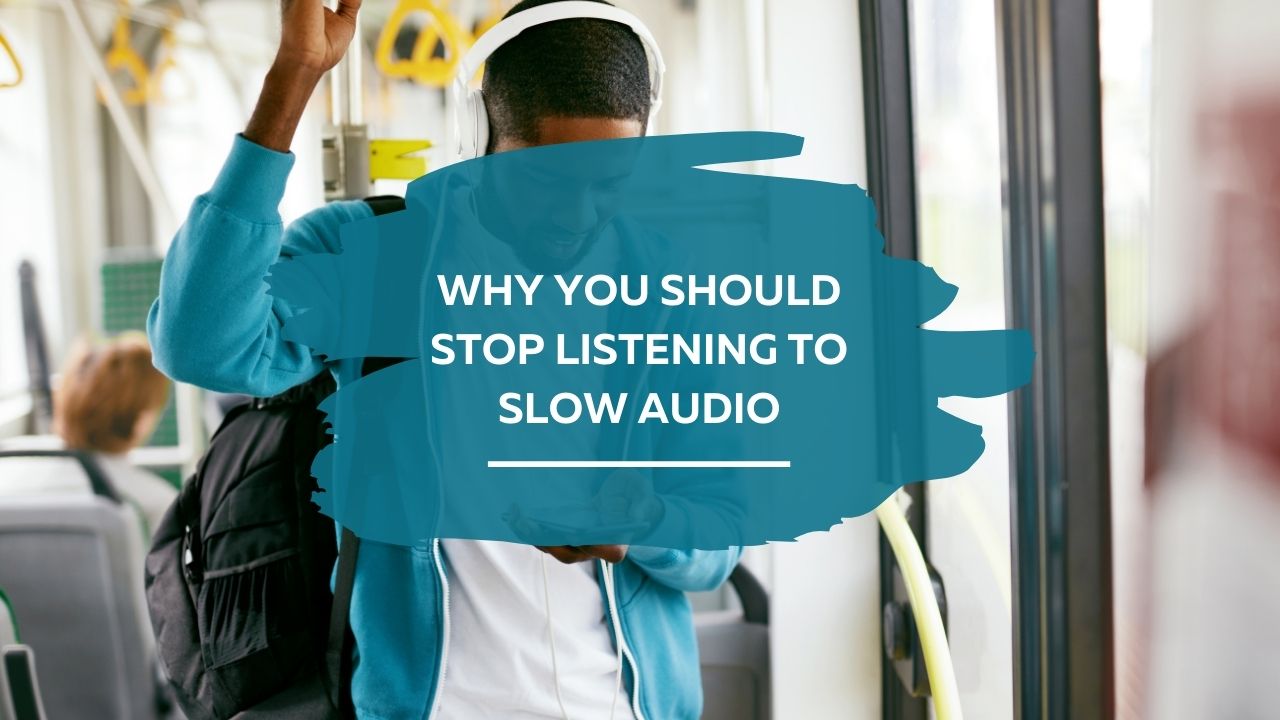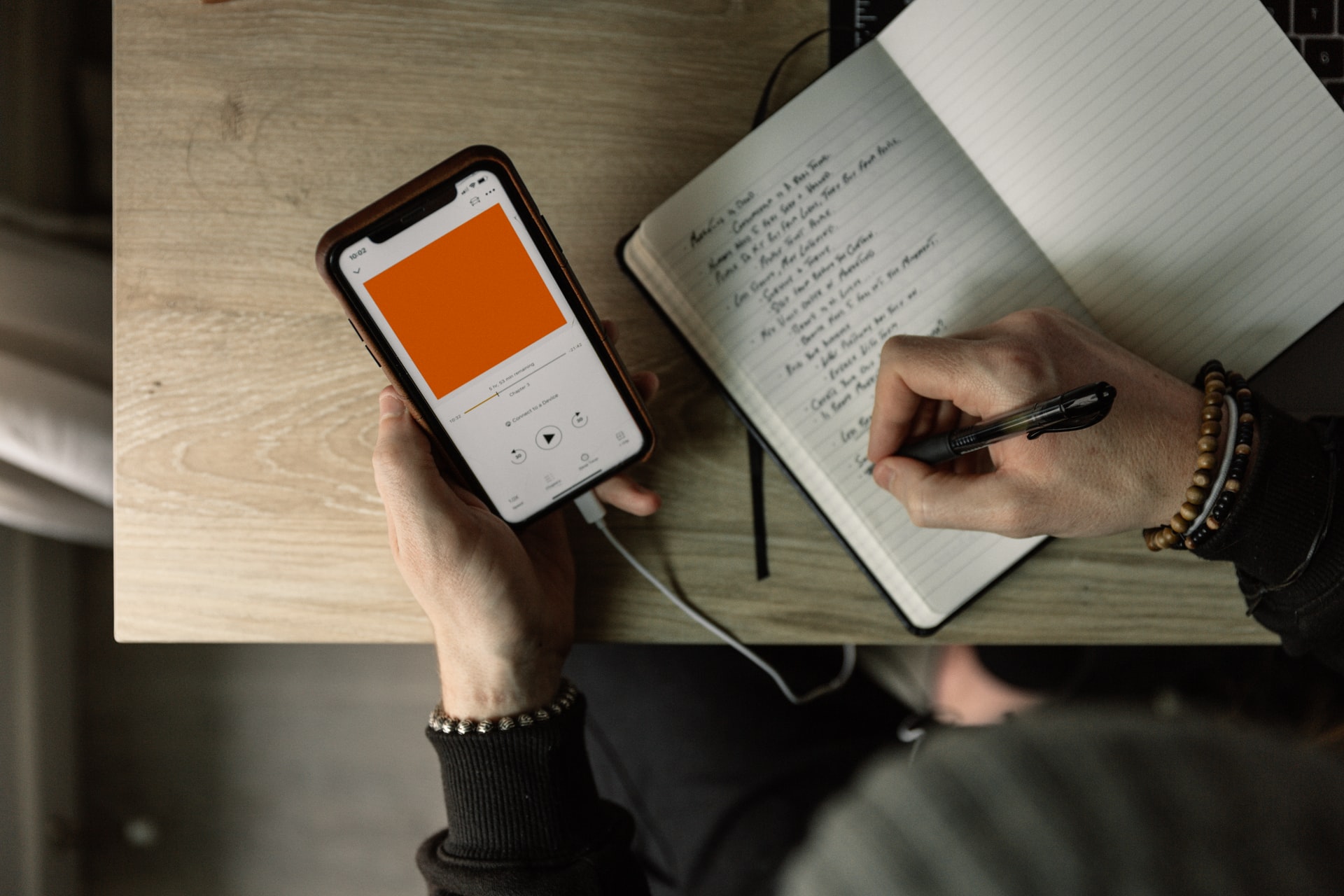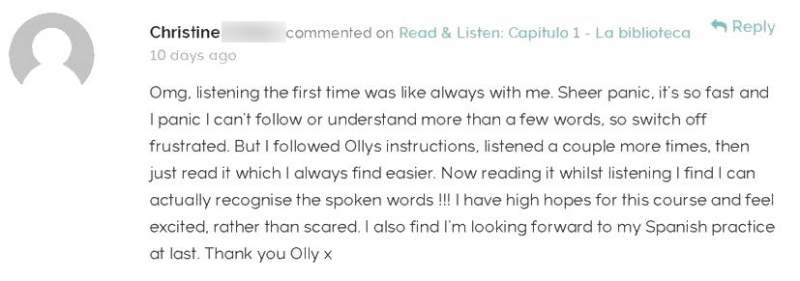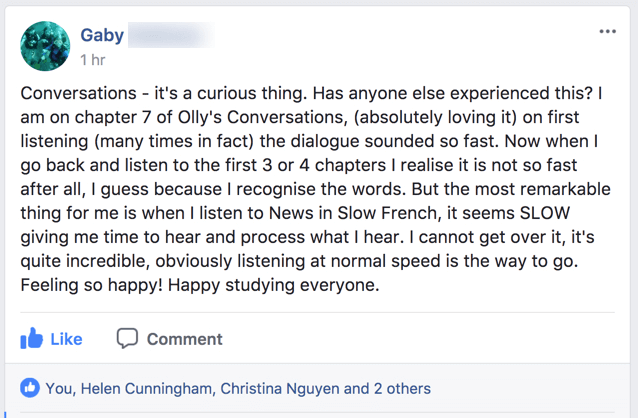
Slow audio – it’s a part of language products I often see mentioned as a “great feature”…
It’s available with a tiny click of the mouse…
But with huge consequences…
Otherwise known as “Listen at ¾ or even ½ speed”.

But is slowing down the audio a good thing?
Is it helping your language learning… or holding you back?
How To Slow Down Audio: A Popular Question
I’ve been prompted to write this post after seeing a growing number of people talking about the virtues of slow audio.
And, of course, as the creator of Conversations – designed with the sole purpose of improving your listening skills – it’s a particularly relevant topic for me (and for you, if you’re a Conversations customer!).
I actually think the area of listening skills is a pretty straightforward one…
There are, as it happens, only ever two reasons you’ll not understand something you hear in a foreign language.
Can you guess what those two reasons are? We'll come back to this later.
Back to the matter at hand….
I first began to notice the “slow audio” topic when many people in the Fluency Mastermind group began talking about a site they like called News In Slow Spanish.
(They have it in other languages too, and I think there are a number of spin-off sites.)
It’s quite appealing at first glance…
“Can’t understand the news on Spanish TV? Oh, well how about we slow it down for you? Then you’ll understand.”
And, of course, it is easier to understand when it's slower.
Next up, I received an email from one customer of Conversations who said…
“I love it, but my one criticism is that the speech is too fast. I prefer tools like Yabla where you can slow down the audio.”
Let’s not also forget the experience we have whenever we go and speak with native speakers in our target language…
“Ahhhh… they speak so fast!”
It’s fair to say that the speed at which people talk is a significant perceived problem in language learning.
Did you notice the bolded word in the last sentence?
Read it again – it’s pretty important for the rest of the article.
If It’s Too Fast, Then Slow It Down! (Right?)

So, if the audio you’re listening to is too fast, isn’t there a problem?
Yep – we can agree on that. A problem for sure.
So, you should slow down the audio, right?
Hmm.
Well, your instincts tell you to slow it down.
And that’s presumably why “slow audio” seems to be so popular – our instincts tell us it’s a good thing…
“If I can’t understand at full speed, but I can understand at ¾ speed,” you think to yourself, “then surely I’ll be better off slowing it down to ¾ so that I can understand!”
Speed is the perceived problem.
Before we can answer this question, we need to take a quick look at why listening to audio at natural speed is hard in the first place.
Why Audio At Natural Speed Is Hard To Understand

OK, pay attention, because this can be a game-changer…
Real language, spoken in the real word, is nothing like your textbook.
And I mean nothing like. (Read: completely different. A different animal altogether.)
(That's why the foundation of the StoryLearning method is reading and listening from the start.)
Firstly, textbook language is…
- Simplified
- Suitable for beginners
- Avoiding difficult vocabulary and grammar.
(But that's ok – as a beginner you need simplified language.)
Secondly, the audio in textbook dialogues is:
- Spoken slowly, clearly and articulately
- by professional voice actors
(Again, perfectly reasonably… it’s made for beginners after all.)
So, all good, right?
Well, here’s the thing…
In the real world, words and phrases are not pronounced like they are in your textbook.
When spoken at natural speed, the “correct” pronunciation of words goes out the window.
The words themselves – the way they’re pronounced – change.
Take a minute to let that sink in.
It’s not just that people speak faster in real life… they actually speak differently.
(It's known as “connected speech“.)
For example, try saying the following sentence aloud, the way it might be read in a textbook: “…despite the fact that he arrived sooner…”
Now, say it at normal, conversational speed.
Hear the difference?
Can you tell all the parts that change?
Here's a representation of all the pronunciation that probably changed when you read it at full speed (this will depend on your accent):

What does this mean?
It means that whenever audio is read slowly and clearly, it loses many the features that make speech real.
And so when you go out and listen to audio that's real, this is why you struggle. (This is why Uncovered courses never slow audio down — you can try them free here.)
OK – time for a quick recap!
Here's what we've established so far…
The language from most foreign language learning resources is unnatural because:
- It's been simplified
- The audio is read at a slow speed, losing many features of natural speech
Now, like I said earlier, this isn't necessarily a bad thing.
As a beginner, you need support.
But where it becomes a problem is when you move beyond the beginner stage and want to learn to understand native speakers – the “real thing”.
(You do want to learn to understand native speakers, right? Just checking…)
Two Reasons You Don't Understand Natural Audio

The major mistake most people make when they start to improve and move beyond the beginner stage in a language, is to keep the same study habits they had as a beginner.
In reality, you need to change how you study.
Here's the deal…
Remember earlier, we said there are only two reasons you'll not understand something you hear in a foreign language?
They are…
- You don't understand the words
- You don't understand how it's pronounced at natural speed
Got that?
Either you don't know the word, or you don't catch it at speed (because of “connected speech”).
Think back to the last time you were listening to something difficult in your target language…
The news, a YouTube video… whatever.
Can you identify which of the two problems above made it difficult to understand?
- Was it because it was you didn't understand the words?
- Or was it because it was too fast to tell the words apart?
Take a second. Think about it.
Here's where the confusion begins…
Why Are You Listening In The First Place?
In my experience, when you struggle with natural audio, most of the time it's because you simply don't know the words.
Sure, it's fast, and that might make you flustered…
But, let's face it…
If you don't know the word, it doesn't matter if it's natural speed or veeerrryyy slllloooooowwwww.
If you don't know it, you don't know it.
And yet, the perceived problem (remember that from earlier?), is the speed.
“Agghh… I don't understand… it's too fast!”
Well, yes, it may be fast, but that's not the main reason you don't understand.
Think about it…
If you're learning Spanish, for example, and a hyper-fast-talking Spanish speaker blurted at you at 100 mph:
“Hola amigo, ¿cómo estás? ¿Todo bien?”
(Hey, how are you? Good?)
Will you understand, even at 100 mph?
Sure you will.
Because you know those phrases inside-out and back-to-front.
Heck, he could say them at 1,000 mph and you'd still get it!
You might chuckle to yourself: “Oh, he speaks kinda fast!”
But you'd still get it.
Where you might run into trouble is if the conversation continued, and got off-topic.
Why?
Yep, because you don't know the words he's using.
(Unless, of course, you've been learning with a powerful input-based method like Spanish Uncovered!)
So, this brings us to a really important question:
“What is the purpose of listening?”
Is the purpose of listening, to:
- Improve your listening skills, or
- Learn new vocabulary, expressions, etc?
Well, it can be both.
You can learn a lot of new language from listening to interesting audio.
And you can also improve your listening skills by doing a lot of listening.
But here's the kicker…
Slow Audio Kills Listening Skills

The minute you slow down the audio, you lose pretty much all the “listening” benefits.
The only benefit of slowing down the audio is to give you more time to understand the difficult words being used.
But this is a vocabulary problem, not a listening problem.
Your instinct tells you to slow it down, so you have more time to listen…
But in fact, the only real “study” benefit of the slow speed is to help you learn the vocabulary.
And if you're spending your time listening to slow audio, how will you ever develop the ability to understand the way native speakers talk at natural speed?
It's really important we separate out the two issues here: vocabulary and listening.
See if you can follow me here…
If you lose the “listening” benefits as soon as you slow down audio, all you're left with is the language content to study.
In other words, you're in full “study mode” at that point – learning the words, analysing the grammar, etc.
And in that case, my question to you is: What's the point of using audio?
Is it a conscious study decision to use the audio?
Probably not.
Or are you just listening to it for the sake of it… because it's there?
Probably.
The crux of the issue is this:
As soon as you slow down the audio and focus on the content, you're basically losing all pretence of practising your listening skills.
Slow speech loses the characteristics of natural speech.
Artificially slowed-down speech (using an app) simply fails to provide your brain with the conditions in which to grow.
Just like going to the gym, regular training with increasingly heavy weights builds big muscles!
Keep using light weights, and you'll stay where you are.
The way to improve your listening skills – your ability to cope with fast, natural speech – is to spend time listening at natural speed.
With a little help…
How To Listen At Full Speed

A lot of what we've spoken about so far has been a battle of intuitions.
If it's too fast… slow it down.
But in reality, by slowing down the audio, you're depriving yourself of the benefits of listening in the first place.
Agh!
Now…
Let's say you've followed me up to here, and you understand the principle that in order to learn to cope with natural speech, you have to listen at natural speed.
You're still left with one big (no, major!) obstacle…
“But I don't understand anything when it's so fast!”
So, let's deal directly with this.
Firstly, you're probably listening to material that's too hard for you. (Most people do.)
If you're at a post-beginner/low intermediate level, for example, and you're listening to podcasts or watching movies, you're out of your depth.
Sure, they're fun, and might be interesting, but if you don't understand anything, there's very little for you to learn.
So, turn off the TV and close YouTube. (The App Villain will get you otherwise!)
The #1 rule is to listen to what's known as Comprehensible Input – material that's just slightly above your current level.
That way, you're not straining too much to understand.
The #2 rule is to use material that comes with full transcripts, so you can read along at the same time as you listen. (Conversations is good for this)
With transcripts, you can see what's being said if you need help, compare the spoken word to the written word, and there is now no need to slow down the audio.
(Read this paragraph again. Let it sink in.)
Let's put this another way:
If the material is at your level (so you're not straining), and you can see transcriptions of what's being said (so there's help when you're uncertain), then you can keep listening to the audio at full speed.
And… just like magic…
If you spend all your time listening to audio at full speed, how much faster do you think you'll learn to understand native speakers when they're chatting away at natural speed?
Yep…
Pretty damn quick.
From Slow Audio To Full Speed – Transformation Comes Quickly!

When you first start listening to audio at full speed, you might feel a bit flustered.
After all, you've conditioned yourself to listening to all that slower (unnatural) stuff.
So, what's required from you at the beginning is a bit of faith!
My promise to you is that if you stick at it for just a couple of weeks, you'll begin to feel the ground literally shifting under your feet.
(This is, of course, providing you've chosen material that's at the right level, and you've got the transcript to help.)
Just look at some student descriptions of what happens when you make this shift:

…this one's from my one of my Uncovered courses, which are built entirely around listening and reading (it's fun!).


… these are from Conversations – which, again, is material specifically designed to focus on listening skills at intermediate level (with full transcripts, of course).
As you can see, the change from listening to natural audio comes quickly.
Not only that, but once you've experienced the feeling of: “OMG, I can actually follow along now at full speed…”
You can never go back to listening to unnaturally slow audio again.
You can taste what it feels like to be in the company of native speakers… and not be lost!
What Is Your Personal Listening Opportunity?

Honestly…
I'm mightily impressed if you're still with me at this point!
It's a tricky topic, and not an intuitive one to grasp… much less actually put into action.
So, good job on making it to this point (unless you're skimming… in which case, go back to the top and start again!!)
What's really important for you to do right now is to reflect on three things:
- How happy are you with listening ability in the language you're learning?
- How much time have you spent “studying language” vs “practising listening”?
- What are the opportunities to improve your study habits, based on what you've read here?
Lastly, let's briefly mention material.
It can be tough to find good study material that fits the advice I've given here:
- At your level (“Comprehensible Input”)
- With transcript (and ideally translation too)
Most so-called listening material, is nothing of the sort!
My strong advice is to take the time necessary to find the right material, because everything changes when you do!
You'll learn faster and enjoy the experience much more.
This can be easier for some languages than others, though.
Conversations is available in Spanish, French, Italian, German, Japanese and Chinese, and is designed specifically to improve your listening skills at an intermediate level.
(There’s also a “pro” version for Cantonese learners!)
You might also like my books of short stories for beginners and intermediate learners, which have audio versions available. (Although just be aware that this is primarily written material, so is more suitable for general learning that listening practice per se.)

Olly Richards
Creator of the StoryLearning® Method
Olly Richards is a renowned polyglot and language learning expert with over 15 years of experience teaching millions through his innovative StoryLearning® method. He is the creator of StoryLearning, one of the world's largest language learning blogs with 500,000+ monthly readers.
Olly has authored 30+ language learning books and courses, including the bestselling "Short Stories" series published by Teach Yourself.
When not developing new teaching methods, Richards practices what he preaches—he speaks 8 languages fluently and continues learning new ones through his own methodology.










































